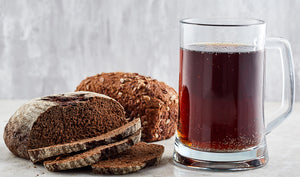What's Different?
The only difference between all grain and extract is how you get your sugars to ferment. With extract, you're getting sugars from malt extract, which is pre-made concentrated un-hopped wort. With all grain, you're extracting starches from malted barley and converting those starches to sugars. So, you're pretty much a chemist.
Here's what you'll need to do different:
Mashing
In the mashing process, you’re making your wort from nothing but grains and water. This process is a lot more time consuming than using malt extract, but it is very rewarding.
During the mashing process, you are adding your grains to hot water between 149 °F (65 °C) and 165 °F (74 °C) and allowing them to mash (steep) for anywhere from an hour to an hour and a half. By doing this, you are activating the enzymes in the malt (beta-amylase and alpha-amylase) and converting the starches into sugars.
Mash temperatures vary depending on the beer style you are brewing. For example; mashing at a lower temperature will activate more beta-amylase, which creates more fermentable sugars, leaving you with a drier beer. Mashing at a higher temperature will activate alpha-amylase, which creates more unfermentable sugars, leaving your beer sweeter and giving it a bigger body.
Sparging
Once your mash is complete, there will still be some sugars left on your grains. Sparging is the process of rinsing your grains to get all of that residual sugar off them and into your wort.
To sparge, you will need another a large pot (often referred to as a HLT or hot liquor tank) to heat up water to 168 °F (76 °C) to 170 °F (78 °C) *do not exceed 170 °F, this can release harsh-tasting tannins into your wort.
There are two main methods of sparging:
-
Batch Sparging
This method is the easiest to perform, and is what most brewers use. This process consists of draining your collected mash water into your boil kettle (the pot you will use to boil your wort) and add enough sparge water to fully submerge your grains and let sit for 10 minutes. Drain the water and repeat this process once more.
-
Continuous Sparging or Fly Sparging
This method is a little more difficult to pull off and requires either a pump or the ability to set your mash tun up higher than your boil kettle. This process consists of draining out your wort from the bottom at the same flow rate at you are adding the sparge water on top of the grain bed. This process can increase your efficiency, but most brewers don’t find it to be a substantial difference.
Boiling
The boiling process for all-grain brewing is the same as extract. Boil all your wort that you collected from your mash, and add your bittering, flavour, and aroma hops as per your recipe.
Chill your wort down with a wort chiller, or use an ice bath method until about 70 °F (21 °C). Transfer into your fermenter and pitch your yeast.
What You'll Need
Mash tun
When brewing all-grain, you will be using around 8 - 12 lbs of grain for a 23 L batch depending on the beer style. This means you’re going to need a large vessel to steep your grains in.
The most common vessel is a water cooler style mash tun, similar to a water cooler you would see at a sporting event. These mash tuns are a great option because they are very heavily insulated and allow you to hold a consistent temperature throughout your whole mashing process. This can also be done in a large pot, but should be wrapped with some kind of insulation to try to avoid a drop in temperature. Another option that is becoming popular for brewers who are switching to all-grain is BIAB (brew in a bag).
This process eliminates the need for a mash tun all together by simply mashing your grains in a large mesh bag that is removed from the vessel at the end of your mash. This process only requires one large pot instead of the three vessels mentioned above. The only downside to BIAB is that it is difficult to do a proper sparge, which may lead to a low efficiency.
False Bottom
A false bottom is exactly what it sounds like. They’re used to separate your grains from your wort (liquid), because otherwise, you would have a chunky beer. There are a few kinds of false bottoms, but all are very similar.
A common style is a mesh plate with legs on the bottom which keeps the entire bottom section of the mash tun grain free. Another option is a dome style false bottom, where you a tube is connected from your spigot (output valve at the bottom of the mash tun) onto the mesh dome which creates a seal on the floor of the mash tun and filters the grain.
Alternatively, you would use a bazooka screen. This is a mesh tube that attached directly to the spigot and filters the grain. This method usually results in more volume loss due to grain absorption.



